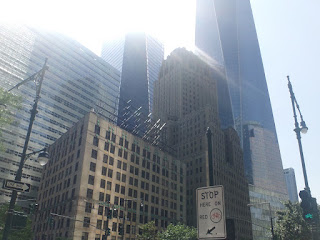I was on a mission this past Saturday, endeavoring to
pinpoint the precise location of a parking lot—a very special one that existed,
once upon a time, in lower Manhattan. The parking lot is no more, but has been
forever immortalized—from my perspective at least—in a 1975 episode of Kojak
called “A Question of Answers.”
In this season-three opener, the incomparable Michael V.
Gazzo played Kojak’s chief antagonist, a super-bad seed named Joel Adrian, who
owned and operated the parking lot in question. Actually, it was the ideal
front business for a cutthroat loan shark. After The Godfather made such
a splash, television mobsters—for some early politically correct reason—were
often given generic-sounding, non-Italian surnames. But we the viewers knew
better. For the year before his guest appearance on Kojak, Gazzo played
Frankie Pantangeli in The Godfather: Part II and won a Best Supporting
Actor Oscar.
It’s strange how things sometimes play out in life. Apparently,
“Leave the gun; take the cannoli” Richard Castellano got too big for his
already big britches and wanted complete control over his dialogue in the
sequel movie. For the record: Castellano’s widow disputed this account,
claiming that her husband didn’t feel his character would betray the Corleone
family. Whatever was stuck in Castellano’s craw, the powers-that-be didn’t
think Peter “Fat” Clemenza was worth it, so they killed him off and brought in
Gazzo as Pantangeli. Castellano got to star in a 1975 sitcom, Joe and Sons,
which I remember watching. The series lasted fourteen episodes. Had Castellano
played “Fat” Clemenza in The Godfather: Part II, it’s unlikely Gazzo
would have appeared in the Kojak episode. And it remains to be seen if I would have gone in search of an old parking lot, which wouldn't have been Michael V. Gazzo’s parking lot.
With that backstory properly digested, Kojak’s “A Question of
Answers” was filmed entirely on location in New York City, when the metropolis
was at its gritty and grimy best—picture perfect. The fiscal crisis
was in full bloom then, impacting everything from the subways, which were
graffiti laden and prone to breakdowns, and the various parks, which were
barely maintained. Emblematic of the times, Michael V. Gazzo’s parking lot was
the genuine article. It stood due north of the Twin Towers, which had opened
only two years earlier, and the thirty-two story New York Telephone Company
building, also known as the Barclay-Vesey building. Built in 1927, this latter
edifice was badly damaged on 9/11, but soldiers on today as the Verizon
headquarters on West Street. It served, too, as my mission’s vital landmark.
I had, in fact, passed by the Verizon building on West
Street many times, but didn’t connect the dots vis-à-vis Michael V. Gazzo’s
parking lot until recently. For that area of Manhattan, Tribeca, bares little
resemblance to its former self. When Kojak filmed there, the old
elevated West Side Highway was visible to the west, although it had been
previously closed to traffic after an eighty-foot section collapsed and sent an
asphalt truck—repairing the deteriorating highway—and automobile to the street
below.
The dilapidated and increasingly obsolete elevated highway
in lower Manhattan was not rebuilt and was gradually torn down. The West Side
Highway is now on the street level—West Street—and zigzags through a rather
hip, expensive part of town. When Michael V. Gazzo’s parking lot existed,
virtually everything to its west was rundown and destined for the ash heap of
history. There’s a new Department of Sanitation building in the vicinity now
and still some factory remnants of what was. But the exact locale of the
parking lot and the surrounding area is currently home to expensive high-rise
buildings, residential and commercial, and a school.
Here’s what New York magazine had to say about the
neighborhood that Michael V. Gazzo’s parking lot once called home: "By many criteria,
Tribeca could be considered the best place to live in the city. It enjoys
minuscule crime levels, great schools, tons of transit, well-planned waterfront
access, and light-filled loft-type apartments in painstakingly rehabbed
industrial buildings. But having already overtaken the Upper East Side as the
city’s richest precinct, it is prohibitively expensive, and any traces of
racial and income diversity are long gone.”
It’s not Michael V. Gazzo’s parking lot anymore—not by a long
shot. Mission accomplished.
(Photos from the personal collection of Nicholas Nigro)





No comments:
Post a Comment
Note: Only a member of this blog may post a comment.